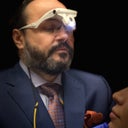Thank you for your question Redoz1122. I understand your concern. Botox is a purified protein used to address wrinkles associated with facial expression. When injected into the skin Botox will relax the muscles and smoothen out the overlying wrinkles. The most common areas of treatment are in the upper face. These include the horizontal lines seen on the upper forehead when one raises the brows, the vertical lines seen between the brows when one frowns (frown lines), and the crow's feet seen around the eyes when one smiles.It is difficult to make an assessment without a formal exam where the entire medical history is reviewed. However, I hope the information provided here is useful.While Botox is best known for its use in cosmetic treatments, there are many other indications for Botox including excessive sweating in the underarms, palms, and soles, migraine headaches, cervical dystonia, spasms of the eye muscles, cross eyes, and bladder dysfunction. It has also been shown to help with depression, premature ejaculation, abnormal heartbeats, cleft lips, and pain with intercourse for women.Botox works to treat migraine headaches in the same way it works to treat wrinkles: by relaxing muscles. In the case of migraine headaches (and sometimes other headaches such as tension headaches) the muscles in the upper face and head contract. This puts pressure on the bones which can be very painful. Botox will relax the muscles to relieve the pain. The areas treated with Botox for migraine headaches are those treated in the upper face. Sometimes additional muscles are also treated with Botox such as those in the temples and back of the head. The dose of Botox used is in the range of 60 to 70 units. Full results are seen in two weeks and after a Botox treatment. However, many patients feel improvement as early as the next day after a Botox treatment. Botox treatment for migraines will significantly reduce the frequency of migraines and is a great alternative for those for whom oral medications are ineffective. Most people enjoy their results from a Botox treatment for three to four months. At that time a maintenance treatment is recommended.If I had a patient with the concern described here I would recommend consulting with a doctor for an evaluation to determine the cause of the pain. If the pain is caused by migraine headaches, then a Botox treatment as described above would likely be helpful.With any injection, there are risks such as pain, bleeding, bruising, redness, swelling, tenderness, and infection. We take special precautions to minimize these risks such as using a painless technique. We also treat bruises with a laser as early as the next day. Bruises usually resolve within two weeks if untreated. After a laser treatment bruises usually resolve in 1-3 days, but may still take two weeks for full resolution. In addition to these risks, with Botox there is also a risk that the product spreads or diffuses to nearby structures. Spread to nearby muscles can lead to side effects such as the temporary appearance of droopy eyelids or a temporary asymmetric smile.


